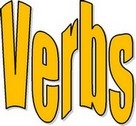Verb Categories
 Verb Categories: Verbs are an essential part of any sentence. They drive the sentence forward, link ideas
and give them meaning.
Verb Categories: Verbs are an essential part of any sentence. They drive the sentence forward, link ideas
and give them meaning.
Verbs conjure strong images of action, colour and feeling. To write well is to use verbs well. Verbs lend a sentence a true sense of movement and purpose.
Verbs can be thought of as being in separate categories:
Being Verbs
These are verbs that link ideas.
I am tired. She was here. That is my car. We were happy.
Being verbs, or to be verbs are also auxillary that help other verbs, He is running.
Doing Verbs
Verbs that are all about action and movement.
He runs quickly. He sleeps. She walks. She hops.
Saying verbs
The verbs that we use to express ways of speaking.
'Go back,' he shouted. 'Not tonight,' he whispered.
Having verbs
Having verbs include verbs such as has, have, had, etc They can be used in a singular form, 'He has a large nose,' or plural, 'We had a good time.' Having verbs also can be used as verb helpers, 'He has spent all his money,' 'By Sunday we will have eaten all our food.'
Auxillary Verbs
Auxillary verbs are verbs that help other verbs to make a complete and logical verb phrase. Following is a list of auxillary verbs (italics)
in sentences.
I am walking.
We are going to the movies.
He was watching us.
We should have waited.
You must bring some food.
Paul is walking down the street.
References
Dykes, B. (1992) Grammar Made Easy: A Guide for Parents and Teachers. Hale & Ironmonger
Merrick, D. (2009) Blake's Grammar Guide for Primary Students. Pascal Press
Content Updated: 03/12
Return from Verb Categories to Home Page
Enjoy this page? Please pay it forward. Here's how...
Would you prefer to share this page with others by linking to it?
- Click on the HTML link code below.
- Copy and paste it, adding a note of your own, into your blog, a Web page, forums, a blog comment,
your Facebook account, or anywhere that someone would find this page valuable.
|